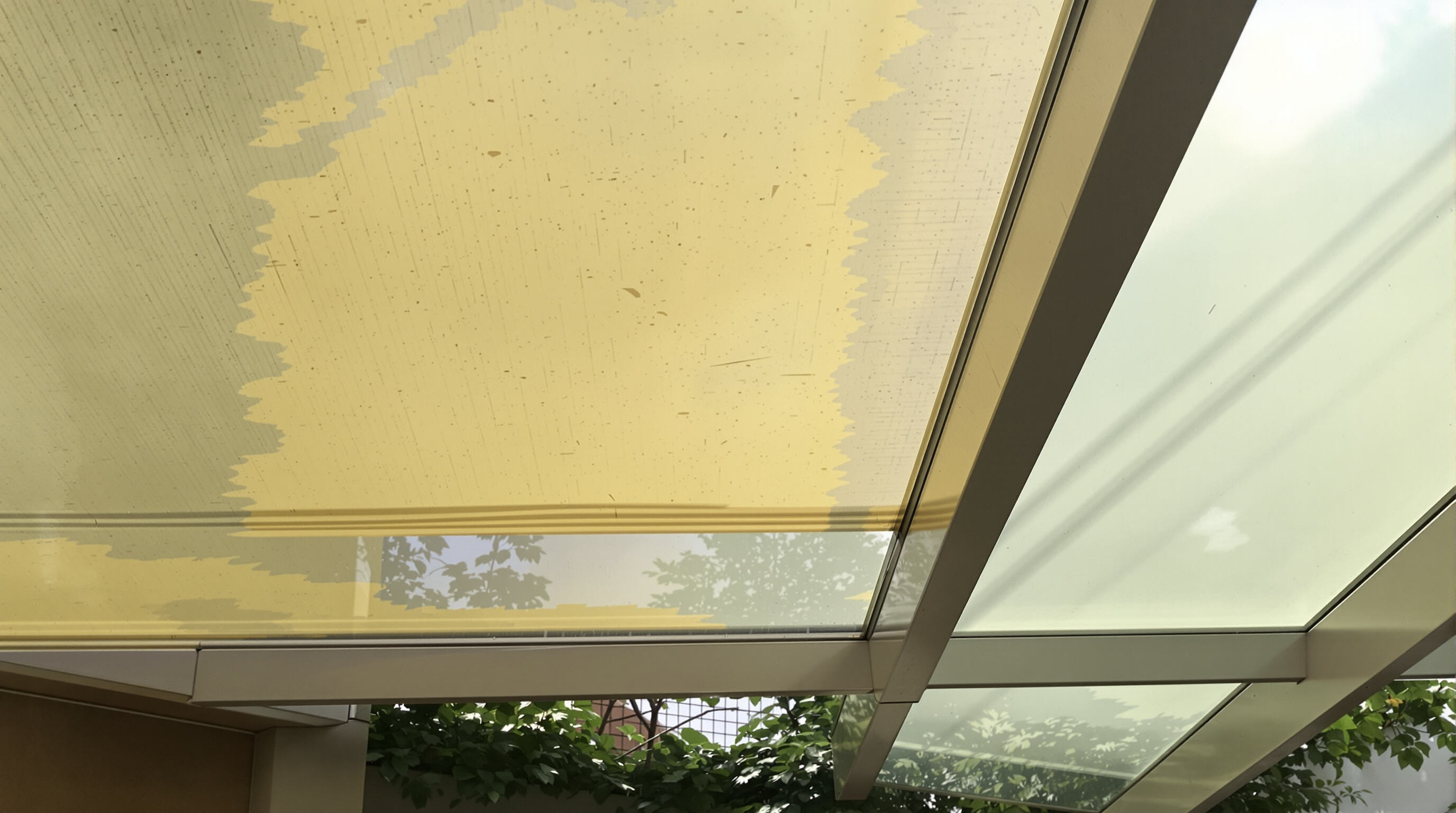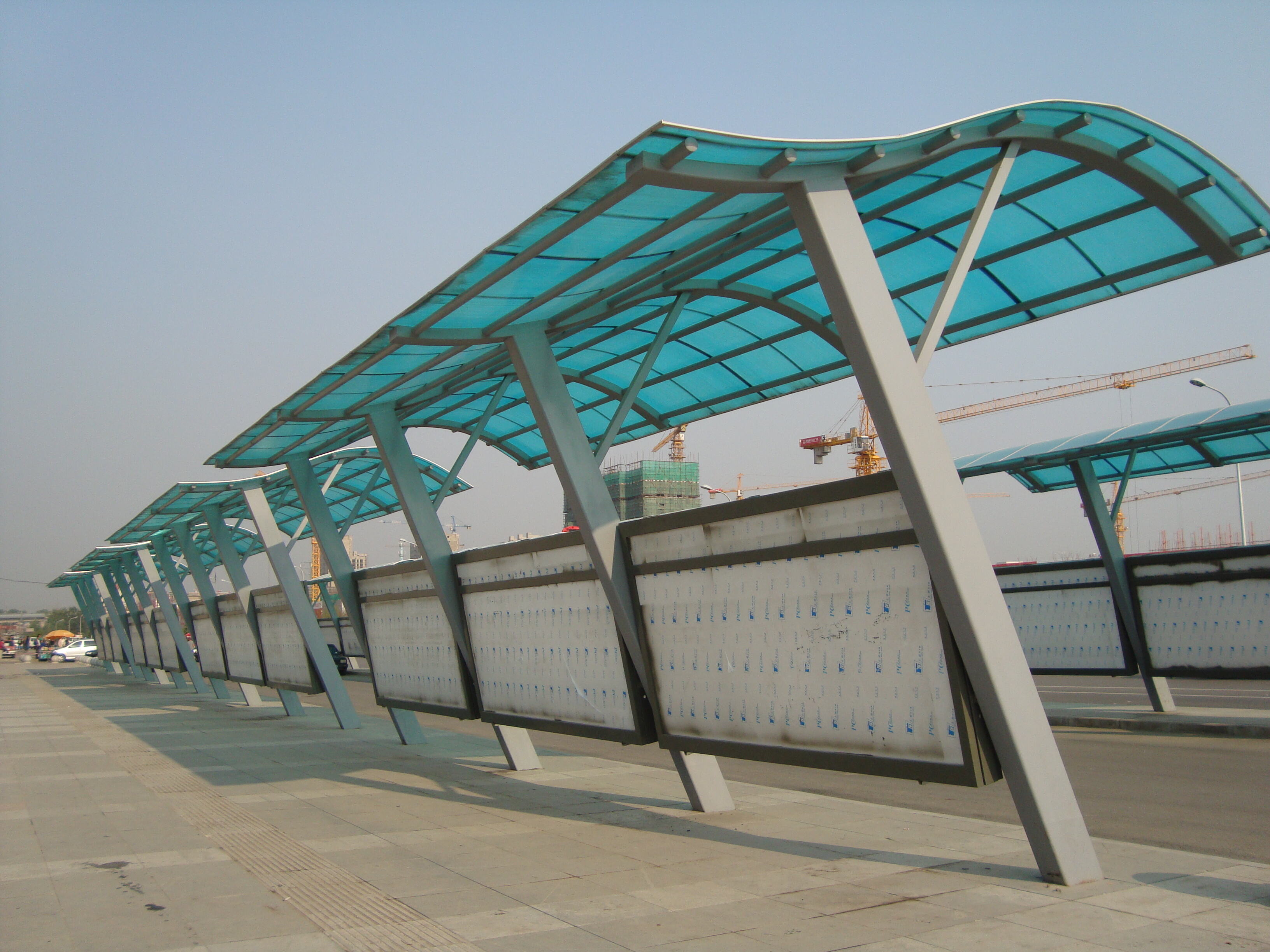폴리카보네이트 캐노피 소재와 환경적 약점 이해하기

폴리카보네이트 지붕 패널의 구성과 자외선 민감성
탄성커버 패널은 고충격 저항성과 빛 투과성을 결합하지만, 그들의 고분자 구조는 자외선에 민감한 결합을 포함합니다. 보호 코팅이 없는 상태에서 자외선은 이러한 결합을 분자 수준에서 파괴하여 점진적인 취화 현상을 유발합니다. 폴리카보네이트는 내구성 면에서 유리를 능가하지만, 장기간의 햇빛 노출은 구조적 무결성을 약화시키는 광분해 연쇄 반응을 시작합니다.
황변과 취화 현상을 유발하는 일반적인 환경 스트레스 요인
공기 중 오염물질, 산성비, 그리고 유기물질 등 다양한 요소들이 폴리카보네이트 소재의 열화를 가속화시키고 있습니다. 기온이 크게 변동하면 패널 표면에서 일어나는 화학 반응이 급격히 증가하게 됩니다. 해안 지역은 염분 분무로 인한 손해를 입게 되며, 도심 지역은 시간이 지남에 따라 이러한 소재를 파괴해 가는 스모그 문제를 겪고 있습니다. 이 모든 문제들이 서로 복합적으로 작용하여 패널의 성능을 저하시키게 됩니다. 연구에 따르면 보호 조치 없이 방치할 경우 일부 패널은 자외선과 다른 환경적 스트레스 요인에 노출되었을 때 단 5년 만에 투명도가 약 30% 정도 감소할 수 있습니다. 이러한 정도의 열화는 제품이 교체되기 전까지의 수명에 상당한 영향을 미치게 됩니다.
천장 구조의 열적 팽창과 수축이 미치는 영향
폴리카보네이트의 열팽창 계수는 섭씨 70 x 10^-6 정도로, 설치 시 허용 오차에 상당히 주의를 기울여야 한다는 의미이다. 일반적인 일일 온도 변화가 약 20도 섭씨인 상황에서 표준 2미터 패널을 예로 들어보자. 이 패널은 실제로 표면 기준으로 약 2.8밀리미터 정도 팽창과 수축이 일어난다. 이러한 움직임으로 인해 고정 장치에 약 38파운드/제곱인치(psi)의 응력이 발생한다. 시간이 지남에 따라 수개월 또는 수년간 반복되는 이러한 하중은 가장 품질이 좋은 하드웨어 부품도 마모되기 시작한다. 결국 이러한 패널 가장자리에 미세한 균열이 생기기 시작한다. 현장 유지보수팀들의 업계 보고에 따르면, 이러한 가장자리 균열이 캐노피 시스템의 대부분의 고장이 발생하는 지점이다.
열화에 대한 업계 데이터: 자외선 보호 없이 5년 동안 투명도 약 30% 감소
처리되지 않은 폴리카보네이트는 자외선 안정제가 첨가된 제품보다 투광도가 3배 빠르게 저하됩니다. 코팅되지 않은 시트는 초기 비용은 낮지만, 수명 주기 분석에 따르면 6~8년 이내 교체가 필요한 경우가 많습니다. 반면, 자외선 차단 코팅 패널은 최대 10년 동안 90%의 투명도를 유지하여 초기 투자 비용이 15~20% 더 들지만 장기적으로는 경제적입니다.
폴리카보네이트 캐노피 표면을 위한 안전하고 효과적인 세척 방법
중성세제와 물을 사용한 폴리카보네이트 시트 세척: 기초적인 방법
물 1리터당 pH 중성 주방용 세제 2~3방울을 혼합한 용액으로 시작하세요. 이 방법은 자외선 보호층을 손상시키지 않으면서 오염물질을 효과적으로 제거할 수 있으며, 처리된 패널은 최대 90%의 투명도를 유지할 수 있습니다(2024년 소재 관리 연구). 표면 손상을 가속화하는 스펀지 패드나 용제 기반 세제는 사용하지 마세요.
스크래치 방지를 위한 마이크로파이버 천과 같은 부드러운 재질 사용
극세사 천은 기존 스펀지보다 긁힘 위험을 73% 줄여줍니다(플라스틱 유지 보수 저널, 2023). 촘촘한 섬유가 세척 중 이물질을 흡착하여 원형 마모를 방지합니다. 찌든 때는 비눗물에 5분간 담근 후 부드럽게 닦아내세요. 깨끗한 표면을 사용하려면 천을 자주 돌려가며 사용하세요.
폴리카보네이트 지붕 및 온실을 안전하게 손으로 청소하는 단계별 가이드
- 먼저 정원 호스로 표면을 헹구어 이물질을 제거하십시오
- 부드러운 털솔 또는 비눗물에 충분히 적신 마이크로파이버 천으로 비눗물을 발라줍니다
- 표면이 빨리 마르는 것을 방지하기 위해 그늘진 곳에서 청소하십시오
- 판넬의 구조적 홈 방향을 따라 닦고, 반대 방향으로 닦지 마십시오
물자국 및 표면 손상을 방지하기 위한 헹구기 및 건조 기술
이온 제거수로 충분히 헹구어 광물질 찌꺼기를 제거하십시오. 깨끗한 마이크로파이버 타월이나 공기 분사 노즐을 사용하여 즉시 건조시키십시오. 잔류 수분 방울은 자외선 노출을 증폭시켜 산화 속도를 22% 증가시킬 수 있습니다(IPCAA, 2023). 대형 설치물의 경우, 고르게 건조하기 위해 구역별로 청소하십시오.
자주 발생하는 손상 원인 회피: 강한 화학제품 및 부적절한 도구
폴리카보네이트에 고압 세척기를 사용하는 위험: 균열 및 박리 위험
1,200 PSI 이상의 고압 세척은 계절적 온도 변화와 함께 폴리카보네이트 표면에 미세 균열을 유발합니다. 2022년 자료 연구에 따르면, 이는 수동 청소 대비 응력 균열을 58% 증가시킵니다. 표면 결함을 통해 침투한 물은 또한 자외선 보호층의 박리 현상을 유발할 수 있으며, 이는 변색 및 강도 저하로 이어집니다.
피해야 할 부식성 물질 목록: 암모니아, 아세톤, 연마제가 포함된 세제
폴리카보네이트가 특히 민감한 물질:
- 암모니아 기반 세제 : 15분 이내에 폴리머 사슬을 분해함
- 아세톤 용매 : 즉각적인 탁광(흐림) 현상을 유발하고 충격 저항성을 40%까지 낮춤
- 마모성 파우더 : 먼지를 갇히게 하는 미세 긁힘 자국을 생성하며 산화 속도를 높임
논란 분석: 소비자 보고서 대 제조사 용매 사용 지침
2023년 설문 조사에 따르면 DIY 사용자의 32%가 희석된 이소프로필 알코올 사용으로 성공적인 결과를 보고했으나, 제조사들은 모든 용매 사용을 전면 권고하지 않습니다. 이 차이는 단기 결과 대비 장기 보존 측면에서 기인합니다. 화학 엔지니어들은 pH 변화를 일으키는 세척제를 단 한 번이라도 사용하더라도 폴리카보네이트의 결정 구조가 영구적으로 변할 수 있음을 확인하고 있습니다.
폴리카보네이트 패널의 완고한 얼룩 관리 및 투명도 복원
수지(나무 수액), 조류 배설물, 경수 얼룩 안전하게 제거
수액이나 새 배설물과 같은 유기성 찌꺼지는 부식을 방지하기 위해 즉시 제거하는 것이 좋습니다. 세척 전 15분 동안 따뜻한 물 찜질을 하여 부드럽게 만든 뒤 닦으면, 문지르 필요 없이 쉽게 제거할 수 있습니다. 센 물자국의 경우, 백식초 용액(물:식초 = 3:1)이 미네랄 찌꺼기를 효과적으로 분해하여 제거할 수 있으며, UV 저항 코팅을 손상시키지 않습니다.
효과적이면서도 자극이 적은 용제: 희석된 이소프로필 알코올 및 pH 중성 세제
산업용 시험에 따르면, 희석된 이소프로필 알코올(농도 10%)은 유기 잔여물의 89%를 제거하면서도 빛 투과율을 유지합니다. 플라스틱용으로 설계된 pH 중성 세제는 미세 균열을 유발할 수 있는 강한 알칼리성 또는 산성 제품 대비 안전한 대안입니다. 아세톤 계열 용제는 보호층을 2~3회 사용만으로도 약화시킬 수 있으므로 사용을 피해야 합니다(PCBC Council, 2021).
사전 처리를 위한 담금 및 비마모성 닦기 기술
정원 스프레이기로 세정 용액을 사용하여 심각하게 오염된 부위를 20분간 사전 침투 처리하십시오. 마이크로화이버 천을 사용하여 수평 방향으로 닦아 빛을 산란시키는 방향성 긁힘 자국을 최소화하십시오. 질감이 있는 패널의 경우 부드러운 브러시 디테일링 브러시를 사용하여 마모 없이 함몰된 부위까지 접근할 수 있습니다.
사례 연구: 유기물 축적이 발생한 농장 온실 캐노피 복원 작업
1,200평방피트 규모의 온실이 효소 세정제와 비직포 패드를 이용한 기계적 교반 처리 후 원래의 투명도의 92%를 회복했습니다. 이후 주간 유지관리를 실시한 결과, 분기별 청소 시와 비교해 재오염 발생률이 73% 감소하였습니다. 이는 자외선 차단을 위한 최선의 관리 방법을 뒷받침하며, 정기적인 관리를 통해 온실의 기능적 수명을 8~12년 연장할 수 있음을 보여줍니다.
예방적 유지보수 및 장기 보존 전략

넘어지기 쉬운 가지들을 잘라내어 물리적 손상과 유기적 손해를 방지하십시오.
천막으로부터 최소 3피트 거리를 두고 나무와 관목을 심으세요. 처마 끝의 가지들은 폭풍 동안 패널을 긁을 수 있으며, 낙엽이나 수액을 떨어뜨려 유기물 축적을 촉진합니다. 이 간단한 단계는 마모를 줄이고 부패한 식물성 물질에서 발생하는 산성 잔여물의 양을 최소화합니다.
건설 작업 또는 꽃가루가 많은 계절에 보호 커버 사용하기
인근 공사 기간 또는 꽃가루가 많은 성수기에는 통기성 있고 자외선에 안정적인 커버를 설치하십시오. 이러한 커버는 마모성 먼지가 쌓이는 것을 방지하고 깊은 청소의 필요성을 줄입니다. 표면 마찰을 피하기 위해 매끄러운 내부 라이닝이 있는 커버를 선택하십시오.
마모 및 손상에 대한 정기 점검: 미세 균열 및 밀봉 고장 확인
패널 가장자리와 밀폐 스트립을 중심으로 반기별 점검을 수행하십시오. 손전등을 사용하여 0.5mm 미만의 미세 균열을 확인하십시오. 이 균열은 초기 누수 원인의 68%를 차지합니다. 손톱으로 가볍게 눌러 밀봉제의 유연성을 점검하십시오. 경화되거나 부서지기 쉬운 소재는 교체가 필요함을 의미합니다.
전략: 캐노피 소유자를 위한 6개월 예방 점검 목록 시행
체계적인 유지보수 계획 채택:
- 배수로를 뚫어 물이 고이는 현상 방지
- 365nm 자외선 손전등을 사용하여 UV 코팅 내구성 테스트
- 패스너가 토크 사양을 충족하는지 확인
- 참조 사진과 함께 빛 투과율 변화 기록
장기적인 명확도 유지에서 UV 보호 코팅의 역할
자외선 저항 코팅은 다층 탄소판에 도달하기 전에 자외선의 99%를 흡수하는 sacrificial 레이어 역할을 합니다. 이는 온실 및 그늘진 테라스에서 일관된 성능을 유지하는 데 필수적인 빛 확산 특성을 보존합니다.
산화가 변색 및 빛 투과율 저하로 이어지는 과정
대기 중 산소는 보호 코팅이 없는 패널에서 연간 0.12μm의 속도로 중합체 사슬과 결합하여 황색 발색기를 형성합니다. 이 과정은 가시광선 투과율을 매년 1.8%씩 감소시키고 적외선 침투를 증가시켜 원치 않는 열 축적에 기여합니다.
데이터 포인트: UV 보호 패널은 10년 동안 최대 90%의 투명도를 유지함 (PCBC 위원회, 2021)
폴리머 건설 기구 컨소시엄(Polymer Construction Board Consortium)이 실시한 가속 노후화 시험에 따르면 코팅된 폴리카보네이트는 시뮬레이션 기준 10년 동안 88~91%의 광투과율을 유지하는 것으로 밝혀졌습니다. 반면, 처리되지 않은 패널은 5년 이내에 투명도가 30% 감소함 (SPONS, 2022).
폴리카보네이트 표면 청소 빈도: 계절별 vs. 월별 필요도
도로 근처의 도심 설치물은 연소 미립자를 제거하기 위해 매월 헹구는 것이 유리함. 농촌 지역의 캐노피는 분기별로 조류 성장을 억제하는 세척이 필요하며, 해안가 지역 건물은 염분 결정체 형성을 방지하기 위해 격월마다 담수로 헹구는 것이 필요함.
지역별 고려사항: 해안가, 도심, 농촌 지역별 유지보수 차이
| 환경 | 주요 위협 | 유지보수 대응 |
|---|---|---|
| 코스탈 | 염분 에어로졸 부식 | 6주마다 이온 제거수(deionized water)로 헹구기 |
| 도시형 | 산성비 식각 | 월간 pH 중성 세정제를 사용하십시오 |
| 농촌 | 생물학적 성장 | 반년에 한 번 항균 처리 |
트렌드: 캐노피 유지보수 알림 일정을 위한 스마트 모니터링 시스템
사물인터넷(IoT) 기반 스트레인 게이지와 광투과 센서는 패널 응력과 투명도에 대한 실시간 데이터를 제공합니다. 이러한 시스템은 기준치에서 5% 이상의 편차가 발생할 경우 경고 알림을 보내며, 가시적인 손상 발생 전에 조기 대응이 가능합니다.
자주 묻는 질문 섹션
폴리카보네이트 캐노피 소재가 취약한 이유는 무엇입니까?
폴리카보네이트 캐노피 소재는 자외선에 민감한 결합 구조, 대기 오염물질 및 산성비와 같은 환경적 스트레스 요인, 그리고 열 팽창과 수축으로 인해 노후화되며, 이로 인해 변색, 취성 및 구조적 손상이 발생할 수 있습니다.
폴리카보네이트 패널의 투명성을 어떻게 유지할 수 있습니까?
세척 시 부드러운 비누와 물을 사용하고, 강한 화학제품이나 연마재는 사용하지 마시며, 자외선 보호 코팅을 적용하여 광분해를 방지함으로써 투명성을 유지할 수 있습니다.
UV 코팅된 패널은 투자할 만한 가치가 있습니까?
예, UV 코팅 패널은 초기 투자 비용이 15~20% 더 들지만 10년 동안 90%의 투명도를 유지하므로 비코팅 패널에 비해 장기적으로 더 경제적입니다.
폴리카보네이트 표면에 사용할 수 있는 추천 청소 도구는 무엇인가요?
폴리카보네이트 표면을 효과적으로 청소하려면 pH 중성 비누, 마이크로파이버 천, 부드러운 헹구는 방법을 사용하여 마모를 방지하고 UV 보호 층을 손상시키지 않도록 합니다.
폴리카보네이트 표면은 얼마나 자주 청소해야 하나요?
청소 빈도는 환경에 따라 다릅니다. 도심 지역은 매월 청소하는 것이 좋고, 농촌 지역은 분기별로, 해안 지역은 염해를 방지하기 위해 2개월에 한 번씩 헹구는 것이 좋습니다.
폴리카보네이트 제품에 고압 세척기를 사용할 경우의 위험은 무엇인가요?
고압 세척기는 미세 균열 및 박리를 유발할 수 있으며, 이는 구조적 손상과 패널 강도 저하로 이어집니다. 부드러운 재질로 수동 청소하는 방법이 더 추천됩니다.
목차
- 폴리카보네이트 캐노피 소재와 환경적 약점 이해하기
- 폴리카보네이트 캐노피 표면을 위한 안전하고 효과적인 세척 방법
- 자주 발생하는 손상 원인 회피: 강한 화학제품 및 부적절한 도구
- 폴리카보네이트 패널의 완고한 얼룩 관리 및 투명도 복원
-
예방적 유지보수 및 장기 보존 전략
- 넘어지기 쉬운 가지들을 잘라내어 물리적 손상과 유기적 손해를 방지하십시오.
- 건설 작업 또는 꽃가루가 많은 계절에 보호 커버 사용하기
- 마모 및 손상에 대한 정기 점검: 미세 균열 및 밀봉 고장 확인
- 전략: 캐노피 소유자를 위한 6개월 예방 점검 목록 시행
- 장기적인 명확도 유지에서 UV 보호 코팅의 역할
- 산화가 변색 및 빛 투과율 저하로 이어지는 과정
- 데이터 포인트: UV 보호 패널은 10년 동안 최대 90%의 투명도를 유지함 (PCBC 위원회, 2021)
- 폴리카보네이트 표면 청소 빈도: 계절별 vs. 월별 필요도
- 지역별 고려사항: 해안가, 도심, 농촌 지역별 유지보수 차이
- 트렌드: 캐노피 유지보수 알림 일정을 위한 스마트 모니터링 시스템
- 자주 묻는 질문 섹션

